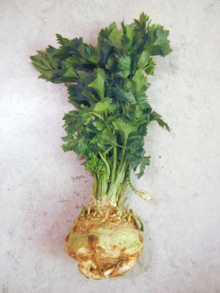| Celeriac | |
|---|---|
 A celeriac hypocotyl sliced in half, and with the greens removed A celeriac hypocotyl sliced in half, and with the greens removed | |
| Genus | Apium |
| Species | Apium graveolens |
| Cultivar group | Rapaceum Group or Celeriac Group |
| Cultivar group members |
|
Celeriac (Apium graveolens Rapaceum Group, synonyms Apium graveolens Celeriac Group and Apium graveolens var. rapaceum), also called celery root, knob celery, and turnip-rooted celery (although it is not a close relative of the turnip), is a group of cultivars of Apium graveolens cultivated for their edible bulb-like hypocotyl, and shoots.
Celeriac is widely cultivated in the Mediterranean Basin and in Northern Europe. It is also but less commonly cultivated in North Africa, Siberia, Southwest Asia, and North America.
History
| This section needs expansion. You can help by adding to it. (April 2022) |
Wild celery (Apium graveolens), from which both celeriac and celery derive, originated in Europe and the Mediterranean Basin. It was mentioned in the Iliad and Odyssey as selinon. Celeriac was grown as a medicinal crop in some early civilizations.
Culinary use

Typically, celeriac is harvested when its hypocotyl is 10 to 14 centimetres (4 to 5+1⁄2 inches) in diameter. This is white on the inside, and can be kept for months in winter. It often serves as a key ingredient in soup. It can also be shredded and used in salads. The leaves are used as seasoning; the small, fibrous stalks find only marginal use.
The shelf life of celeriac is approximately six to eight months if stored between 0 and 5 °C (32 and 41 °F), and not allowed to dry out. However, the vegetable will tend to rot through the centre if the finer stems surrounding the base are left attached. The centre of celeriac becomes hollow as it ages, though even freshly harvested celeriacs can have a small medial hollow. The freshness will also be obvious from the taste; the older it is, the weaker the celery flavour.
| Nutritional value per 100 g (3.5 oz) | |||||||||||||||||||||||||||||||||||||||||||||||
|---|---|---|---|---|---|---|---|---|---|---|---|---|---|---|---|---|---|---|---|---|---|---|---|---|---|---|---|---|---|---|---|---|---|---|---|---|---|---|---|---|---|---|---|---|---|---|---|
| Energy | 176 kJ (42 kcal) | ||||||||||||||||||||||||||||||||||||||||||||||
| Carbohydrates | 9.2 g | ||||||||||||||||||||||||||||||||||||||||||||||
| Sugars | 1.6 g | ||||||||||||||||||||||||||||||||||||||||||||||
| Dietary fibre | 1.8 g | ||||||||||||||||||||||||||||||||||||||||||||||
| Fat | 0.3 g | ||||||||||||||||||||||||||||||||||||||||||||||
| Protein | 1.5 g | ||||||||||||||||||||||||||||||||||||||||||||||
| |||||||||||||||||||||||||||||||||||||||||||||||
| Other constituents | Quantity | ||||||||||||||||||||||||||||||||||||||||||||||
| Water | 88 g | ||||||||||||||||||||||||||||||||||||||||||||||
Link to USDA Database entry | |||||||||||||||||||||||||||||||||||||||||||||||
| Percentages estimated using US recommendations for adults, except for potassium, which is estimated based on expert recommendation from the National Academies. | |||||||||||||||||||||||||||||||||||||||||||||||
See also
Explanatory notes
- Σέλινον has been translated by Lattimore as "the parsley that grows in wet places," by Murray as "parsley of the marsh," and by Butler as "wild celery."
References
- ^ "Apium graveolens Rapaceum Group". NCBI Taxonomy Browser. National Center for Biotechnology Information. Retrieved 28 May 2024.
- Watson, Molly. "All About Celery Root (Celeriac)". localfoods.about.com. Archived from the original on 25 November 2009. Retrieved 29 April 2014.
- Zanteson, Lori (7 November 2019). "Health benefits of celery root may just surprise you". Chicago Sun-Times. Retrieved 29 June 2023.
- ^ Chisholm, Hugh, ed. (1911). "Celery" . Encyclopædia Britannica. Vol. 5 (11th ed.). Cambridge University Press. p. 500.
- ^ Schuchert, Wolfgang. "Celeriac (Apium graveolens L. var. rapaceum)". Crop Exhibition. Max Planck Institute for Plant Breeding Research. Archived from the original on 20 May 2012. Retrieved 28 January 2012.
- ^ "Celeriac (Apium graveolens rapaceum)". Growing Taste: A Home Food-Gardening Resource.
- "Apium graveolens L.", Plants of the World Online, Royal Botanic Gardens, Kew, retrieved 28 May 2024
- The Iliad of Homer. 2.776 .
- ^ Staub, Jack (29 November 2006). "The Vegetable World's Ugly Duckling: Celeriac". NPR. Retrieved 9 July 2022.
- "eat celery root". eattheseasons.com. 2010. Retrieved 29 April 2014.
- Farooqi, A. A.; Kathiresan, C.; Srinivasappa, K. N. (1 January 2006), Peter, K. V. (ed.), "17 – Celeriac", Handbook of Herbs and Spices, Woodhead Publishing Series in Food Science, Technology and Nutrition, Woodhead Publishing, pp. 313–316, ISBN 978-1-84569-017-5, retrieved 9 July 2022
- ^ "Small-scale postharvest handling practices – A manual for horticultural crops – 3rd edition". FAO Agriculture and Consumer protection. March 1995. Archived from the original on 24 September 2015. Retrieved 29 April 2014.
- United States Food and Drug Administration (2024). "Daily Value on the Nutrition and Supplement Facts Labels". FDA. Archived from the original on 27 March 2024. Retrieved 28 March 2024.
- National Academies of Sciences, Engineering, and Medicine; Health and Medicine Division; Food and Nutrition Board; Committee to Review the Dietary Reference Intakes for Sodium and Potassium (2019). "Chapter 4: Potassium: Dietary Reference Intakes for Adequacy". In Oria, Maria; Harrison, Meghan; Stallings, Virginia A. (eds.). Dietary Reference Intakes for Sodium and Potassium. The National Academies Collection: Reports funded by National Institutes of Health. Washington, DC: National Academies Press (US). pp. 120–121. doi:10.17226/25353. ISBN 978-0-309-48834-1. PMID 30844154. Retrieved 5 December 2024.
External links
- Nutritional Summary for Celeriac , cooked, boiled, drained, without salt
- "RHS Award of Garden Merit: Asparagus, Celeriac , chard, Chinese cabbage, fennel, melon, pak choi, rhubarb 2011". Archived from the original on 8 July 2013. Retrieved 31 January 2012. (306 KB)
| Taxon identifiers | |
|---|---|
| Apium graveolens var. rapaceum | |
| Apium rapaceum | |